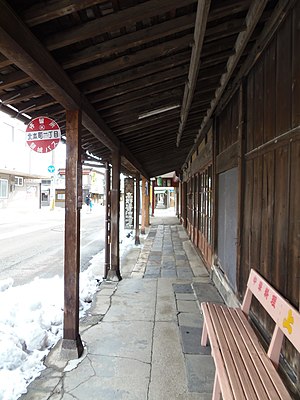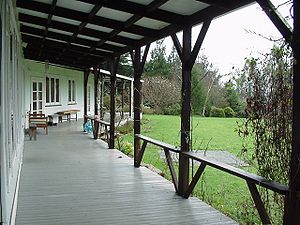Veranda
This article needs additional citations for verification. (January 2021) |

A veranda or verandah is a roofed, open-air gallery or porch, attached to the outside of a building.[1][2] A veranda is often partly enclosed by a railing and frequently extends across the front and sides of the structure.[3]
Although the form verandah is correct and very common, some authorities prefer the version without an "h" (the Concise Oxford English Dictionary gives the "h" version as a variant and The Guardian Style Guide says "veranda not verandah").[4] Australia's Macquarie Dictionary prefers verandah.[5]
Architecture styles notable for verandas
Australia
The veranda has featured quite prominently in Australian vernacular architecture and first became widespread in colonial buildings during the 1850s. The Victorian Filigree architecture style is used by residential (particularly terraced houses in Australia and New Zealand) and commercial buildings (particularly hotels) across Australia and features decorative screens of wrought iron, cast iron "lace" or wood fretwork. The Queenslander is a style of residential construction in Queensland, Australia, which is adapted to subtropical climates and characterized in part by its large verandas, which sometimes encircle the entire house.
Brazil
The bandeirista style house from Brazil typically has a veranda positioned to face the sunrise.[6]
Japan

In regions with heavy snowfall, especially Aomori and Niigata prefectures, structures called Gangi-Zukuri (ja:雁木造) have been developed since the Edo period. For example, the total length of Gangi in old Takada city is over 16 Kilometers.[7]
Poland
In Poland, the word "weranda" is commonly used for the unheated roofed annex to a house, without walls or with glass walls.[citation needed]
United States
The Creole townhouse in New Orleans, Louisiana, is also noted for its prominent use of verandas. In fact, most houses constructed in the Southern United States before the advent of air conditioning were built with a covered front porch or veranda.
Spanish Colonial architecture (as well as the "Mission style" revivalist version that became popular in the Western United States in the early 1900s) commonly incorporates verandas, both on the exterior of buildings and, in cases of buildings with courtyards, along the interior walls of courtyards. In some cases, homes were constructed with every room opening into a courtyard veranda, rather than interior corridors or direct connections to other rooms.
India
Being a warm, tropical country, porches were a natural idea in India. In North India the porch area is called the Otala, these structures are not only used too cool off, but also as a center of social life, where neighbors can talk and kids play, but also a religious center, where rituals and worship of the Gods can take place.[8] The exact origin of the structure is not yet known, but it appears to date back at least 500 years, making it a well established Indian design.
In Southern India, the term thinnai is used, and these structures are very common. This area serves a religious purpose in addition to a social one, and is the center of everyday life for many. [9] Konkan's architecture is influenced by nature. It is sustainable and cost effective. In Konkan traditional architecture, the veranda is called "Otti", a semi-open space with low height seating covered with a permanent roof. It serves as a transition space leading to an enclosed environment. Sometimes the sides are covered by wooden jali walls. It offers temporary resting space to house members during the afternoon and evening time.
Sri Lanka
Given its Portuguese, Dutch and British rule, many colonial Sri Lankan bungalows feature verandas. In the Sri Lankan Walauwa (a house once used by headmen under colonial rule) it is used as a space for leisure where families will spend time or read newspapers. Given the rarity of the architectural style in contemporary Sri Lanka houses with verandas are often featured in local films and dramas and symbolise a wealthy household.
Hong Kong
Often appear on the upper floor of the first - third generation of Tong Lau (shophouse) due to lack of space since the 19th century.
See also
References
- ^ Poppeliers, John C. (1983). What Style is it?. New York: John Wiley & Sons. p. 106. ISBN 0-471-14434-7.
- ^ "Glossary of Anglo-Indian words - Veranda". University of Chicago. Retrieved 2015-07-08.
- ^ Ching, Francis D.K. (1995). A Visual Dictionary of Architecture. New York: John Wiley and Sons. p. 25. ISBN 0-471-28451-3.
- ^ "Guardian and Observer style guide: V | Info | the Guardian". TheGuardian.com. Archived from the original on 2014-01-21. Retrieved 2016-12-18. The Guardian Style Guide
- ^ "Macquarie Dictionary". www.macquariedictionary.com.au.
- ^ Cardinal-Pett, Clare (2015). A History of Architecture and Urbanism in the Americas. Routledge. ISBN 978-1317431244. Retrieved 30 September 2016.
- ^ Gangi Dori (covered walkways) Joetsu Information Web Site
- ^ https://www.researchgate.net/publication/343908887.
{{cite web}}: Missing or empty|title=(help) - ^ Mohanram, Anupama (22 April 2022). "Why we need the thinnai". The Hindu.
External links
- CS1 errors: missing title
- CS1 errors: bare URL
- Articles with short description
- Short description with empty Wikidata description
- Articles needing additional references from January 2021
- All articles needing additional references
- All articles with unsourced statements
- Articles with unsourced statements from November 2017
- Commons category link is the pagename
- AC with 0 elements
- Architectural elements
- Architecture of Barbados
- Hindi words and phrases


